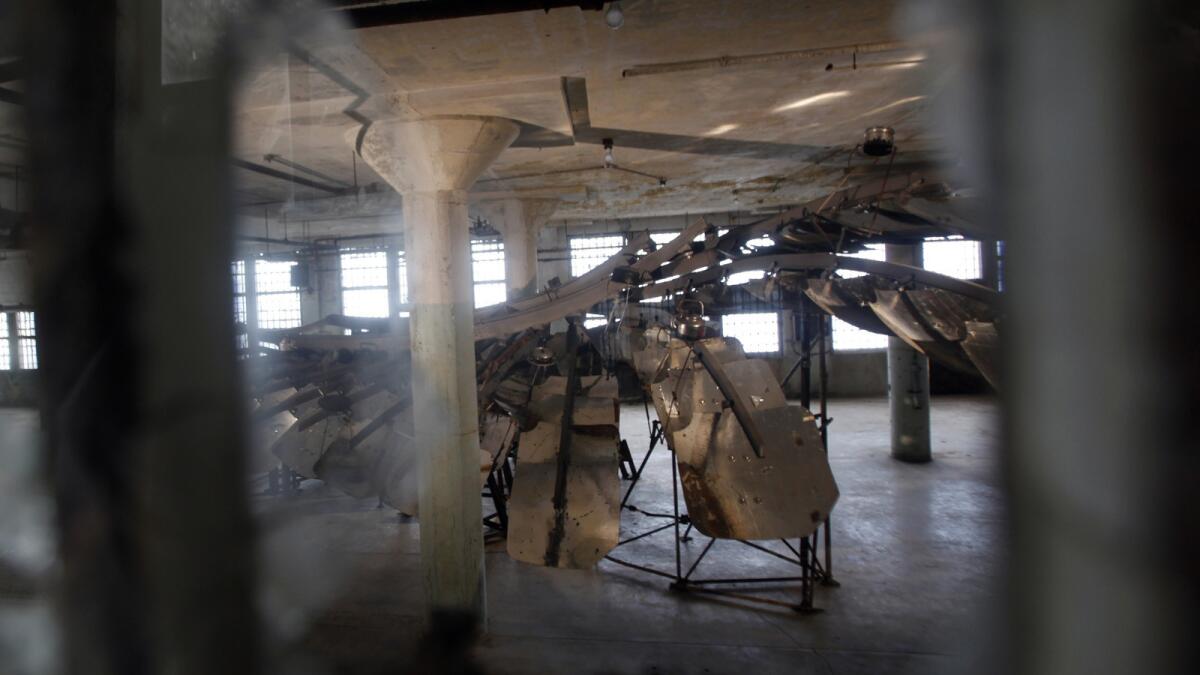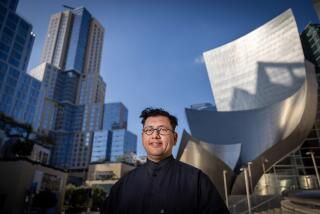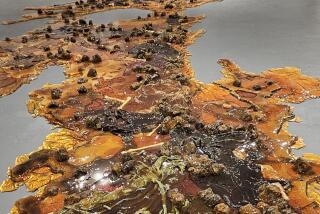In Ai Weiwei show at Alcatraz, tourism and human rights go hand in hand

“@Large:
- Share via
Reporting from SAN FRANCISCO — Cheryl Haines sat with China’s dissident artist and activist Ai Weiwei in his Beijing studio in 2012 — not long after his release from 81 days in secret detention. She could tell he was suffering.
“I’m here as your friend,” Haines, a San Francisco gallerist and founding executive director of the For-Site Foundation told him. “Is there anything I can do for you?”
When Ai responded that Haines could bring his work to a wider audience, the idea struck her.
“What if I can find you a prison?” she asked. Haines had imagined working on Alcatraz Island. Now she had the right artist.
With that, “@Large: Ai Weiwei on Alcatraz,” an exhibition that has transformed and added a dimension to the world-renown tourist attraction in San Francisco Bay, was set in motion.
For-Site, which is dedicated to the creation, presentation and understanding of art about place, had previously collaborated with the National Park Service and the nonprofit Golden Gate National Parks Conservancy to lure new visitors to historic Fort Point, under the Golden Gate Bridge.
The Alcatraz exhibition, which ends Sunday, brought them together again for what Kate Bickert, the conservancy’s director of park initiatives and stewardship, calls one of the most significant park service efforts “as far as the scale, the reputation of the artist and the complexity of the venue.”
To a site often flattened into a caricature as the onetime home of mobster Al Capone, Ai has layered on a contemporary meditation on political imprisonment, freedom of speech and the power of creativity as a force that can better society.
Conservancy officials say the goal to entice new park visitors has been accomplished. By April 1, the show had increased visits from the nine-county Bay Area region by 66%.
Ai’s wish to reach a wider audience has been realized as well. More than 757,000 visitors have come to Alcatraz since the show opened in September, a 13% increase in individual ticket sales over the same period the year before. For-Site brought Internet access to the island for the exhibition, prompting more than 6,000 tweets and other social media postings.
And the show fostered a human rights campaign: Through the piece titled “Yours Truly,” 75,000 postcards have been mailed to prisoners and exiles whose likenesses adorn “Trace,” a floor piece assembled from 1.2 million Legos. (Americans Edward Snowden and Chelsea Manning are among them.)
Ai’s art has also helped first-time visitors discover a deeper Alcatraz, one that National Park Service rangers and volunteer docents urge them to explore.
It is not just the cold and desolate former federal penitentiary that housed Prohibition-era gangsters, but the onetime military prison that in the late 1800s held Hopi tribal members who opposed forced education of their children in Indian boarding schools; the home to conscientious objectors during World War I; and the site of a historic 19-month Native American occupation that began in 1969.
On a recent day, Elena Schmid, 72, sat on a steel stool centered in a cramped cell listening to “Study for String Orchestra,” composed by Pavel Haas in the Terezin concentration camp before he was killed at Auschwitz. The piece is part of the “Stay Tuned” sound installation on the cellblock.
Born and raised in San Francisco, Schmid had never come to Alcatraz, dismissing it as a tourist trap. But the show left her breathless in its power “because of the location.”
Strolling down the hill from the nearby New Industries Building, open to the public only for the exhibition and housing three of Ai’s largest works, was Cathy Crystal of Oakland, making her first sojourn to the island because of Ai — after 50 years as a local.
Once there, she reveled in the beauty of the historic gardens, first planted by prisoners and painstakingly re-created over the last decade.
Katie Caprio, 17, and her mother Peggy Caprio, 52, learned of the exhibition — and the artist — only after buying Alcatraz tickets. The duo from New Jersey sat in the cellblock dining hall on a recent afternoon, poring over a binder filled with stories of the 176 political prisoners featured in “Trace.”
“What you are standing up for is so important, and your actions are not unnoticed,” Katie wrote on a postcard to Iranian woman’s rights activist Bahareh Hedayat. “You are very brave and special, and I truly appreciate what you are doing.
“It’s a cool way to connect,” she said, after signing with a heart. “We don’t really learn about this kind of stuff in school.”
The park service and conservancy have collaborated for years on a number of smaller-scale art projects, recently bringing “Hamlet” and “Macbeth” to Alcatraz along with other site-specific installations.
For-Site has worked with the Presidio Trust to curate the largest collection of Andy Goldsworthy’s work in North America. It was during “International Orange,” the 2012 Fort Point exhibition on the 75th anniversary of the Golden Gate Bridge, that Haines’ eyes settled on Alcatraz. She and Bickert started to talk.
Alcatraz needed major seismic improvements. Donors to the conservancy, which supports the district’s national parks, are generally local. But visitors to Alcatraz are not.
“I said, ‘We do have a real interest in shining a light on Alcatraz,’ ” Bickert recalled. “ ‘Let’s see if this is even possible.’ ”
Frank Dean, then-superintendent of the Golden Gate National Recreation Area, was intrigued. Despite the popularity of Alcatraz, he said, “it seemed like we were missing an opportunity to talk about ... the deeper issue of incarceration.”
By the time the project received final approval — including sign-off from the U.S. State Department — just 10 months remained until opening day. No public funds were used for the show, and For-Site scrambled to raise $4 million. The conservancy hired 60 art guides to help visitors navigate the experience. Haines made six visits to Ai’s studio so he could pore over architectural renderings, videos of the spaces, and books and films on the history of the island.
Signage had to be created, nesting birds and historic buildings protected, and the pieces created, then transported and installed without the benefit of Ai’s presence. (The Chinese government is holding his passport.) About 100 volunteers worked to assemble “Trace,” the Lego installation, first signing nondisclosure agreements.
Dean, who recently retired, was taking a risk. He knew the themes but would not see the work until installation. “We know he likes to pull the giant’s tail,” he said. “That’s how he questions authority.”
Some tourists drawn to Alcatraz exclusively for the cellblock audio tour ignore the work. But the art guides note that it can be accessed on many levels.
“We’re not sort of into art as such,” said Mary Nichol, 68, visiting from Wales. But she called the bright captive dragon that anchors “With Wind” and the feat of assembling 1.2 million Legos “incredible” and said the “Trace” portraits “meant something to me” because a man at her church each Christmas sells postcards for congregants to mail to political prisoners.
A conservancy program has given more than 7,000 tickets to those who could not have afforded full price or had an interest in the show’s overarching themes, Bickert said. Nearly 4,000 have been youth tickets.
Peter Carpou, 64, an art program liaison for Larkin Street Youth in San Francisco, has as a result brought three groups of homeless teens to view the show. He wanted them to see “what lengths people will go through to make sure freedom is a right to fight for and protect.”
The show, he said, “is a master stroke.... The sum of its parts just far exceeds that it’s an art show and it’s a prison.”
A closing celebration will feature the family of a political prisoner from Bahrain and the U.S. head of Amnesty International — a partner on the “Yours Truly” exhibition, which recently bestowed on Ai its Ambassador of Conscience Award. Ai, who is regularly provided notes and images from viewers and has also watched uploaded videos of the exhibition — including an impromptu performance by a youth choir at the “Trace” installation — may even be present via Skype.
“He’s thrilled,” Haines said. “He’s very grateful.”
More to Read
The biggest entertainment stories
Get our big stories about Hollywood, film, television, music, arts, culture and more right in your inbox as soon as they publish.
You may occasionally receive promotional content from the Los Angeles Times.











